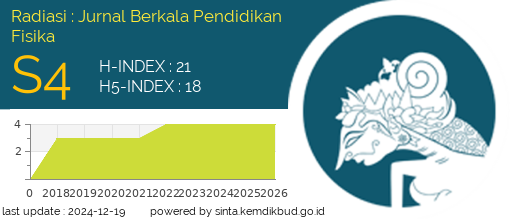Guided Inquiry Model Assisted with TPACK Strategy Influence Students Learning Outcomes
Abstract
This study aims to improve physics learning outcomes of SMA Negeri 11 Banda Aceh students through the implementation of guided inquiry TPACK strategy. The background of this research is students' underutilization of computer laboratory and science laboratory equipment. The research approach used was a pre-experimental design with one pretest and one posttest group. This research sample included 31 students from class XI MIPA 3. The results revealed a considerable improvement in problem-solving ability in Physics after using the guided inquiry TPACK method. The average score of the students' pretest was 33.55, but it increased to 88.06 in the posttest. The test data analysis indicated an average N-Gain score of 81.88%, this shows the positive influence of the implementation of TPACK learning method on student learning outcomes. By applying the guided inquiry TPACK method, this study contributes to overcome the issue of low physics learning outcomes at SMA Negeri 11 Banda Aceh. It is intended that this research would encourage Physics teachers to apply the TPACK technique in their classrooms in order to improve student learning outcomes and employ laboratory equipment to its fullest potential.
Downloads
References
Y. Laoli and W. Bunawan, “Implementasi Pedagogical Content Knowledge (PCK) Berbasis Inkuiri Terbimbing Terhadap Hasil Belajar Siswa,” J. Inov. Pembelajaran Fis. INPAFI, vol. 5, no. 04, pp. 82–90, 2017.
L. Sumardi, A. Rohman, and D. Wahyudiati, “Does the Teaching and Learning Process in Primary Schools Correspond to the Characteristics of the 21st Century Learning?.,” Int. J. Instr., vol. 13, no. 3, pp. 357–370, 2020.
H. Heflin, J. Shewmaker, and J. Nguyen, “Impact of mobile technology on student attitudes, engagement, and learning,” Comput. Educ., vol. 107, pp. 91–99, 2017.
A. Ilmi and W. Sunarno, “Development of TPACK based-physics learning media to improve HOTS and scientific attitude,” presented at the Journal of Physics: Conference Series, IOP Publishing, 2020, p. 012049.
S. Astutik and B. K. Prahani, “The Practicality and Effectiveness of Collaborative Creativity Learning (CCL) Model by Using PhET Simulation to Increase Students’ Scientific Creativity.,” Int. J. Instr., vol. 11, no. 4, pp. 409–424, 2018.
N. Fazriyah, Y. Supriyati, and W. Rahayu, “The Effect of Integrated Learning Model and Critical Thinking Skill of Science Learning Outcomes,” J. Phys. Conf. Ser., vol. 812, p. 012014, Feb. 2017, doi: 10.1088/1742-6596/812/1/012014.
F. S. Irwansyah, I. Ramdani, and I. Farida, “The development of an Augmented Reality (AR) technology-based learning media in metal structure concept,” Ideas 21st Century Educ., pp. 233–238, 2017.
V. Vijayan and V. Joshith, “Technological pedagogical content knowledge: A framework for 21st century teacher cognition,” Int. J. Res. Anal. Rev., vol. 5, no. 3, pp. 325–329, 2018.
D. Akyuz, “Measuring technological pedagogical content knowledge (TPACK) through performance assessment,” Comput. Educ., vol. 125, pp. 212–225, 2018.
H. Herizal, N. Nuraina, R. Rohantizani, and M. Marhami, “Profil TPACK Mahasiswa Calon Guru Matematika dalam Menyongsong Pembelajaran Abad 21,” JISIP J. Ilmu Sos. Dan Pendidik., vol. 6, no. 1, 2022.
M. Hasanah and D. Sulisworo, “Design TPACK Strategy with Modellus Software for Simulation Based on The Guided Inquiry on The Wave Concept,” J. Ilm. Pendidik. Fis., vol. 6, no. 1, pp. 99–107, 2022.
N. Hidayati and N. Alwiyah, “Technological Pedagogy And Content Knowledge: Digitizing 21st Century Learning,” -Tarbawi J. Kaji. Kependidikan Islam, vol. 7, no. 2, pp. 61–70, 2022.
Y.-F. Yeh, K. K. H. Chan, and Y.-S. Hsu, “Toward a framework that connects individual TPACK and collective TPACK: A systematic review of TPACK studies investigating teacher collaborative discourse in the learning by design process,” Comput. Educ., vol. 171, p. 104238, 2021.
M. J. Swallow and M. W. Olofson, “Contextual understandings in the TPACK framework,” J. Res. Technol. Educ., vol. 49, no. 3–4, pp. 228–244, 2017.
J. Tondeur, R. Scherer, F. Siddiq, and E. Baran, “Enhancing pre-service teachers’ technological pedagogical content knowledge (TPACK): A mixed-method study,” Educ. Technol. Res. Dev., vol. 68, pp. 319–343, 2020.
P. Irdalisa, “Djukri.(2020). Implementation of technology-based guided inquiry to improve tpack among prospective biology teachers,” Int. J. Instr., vol. 13, no. 2, pp. 33–44.
R. D. Puspitasari, M. Mustaji, and R. D. Rusmawati, “Model Pembelajaran Inkuiri Terbimbing Berpengaruh terhadap Pemahaman dan Penemuan Konsep dalam Pembelajaran PPKn,” J. Ilm. Pendidik. Dan Pembelajaran, vol. 3, no. 1, pp. 96–107, 2019.
M. Afandi, E. Chamalah, O. P. Wardani, and H. Gunarto, “Model dan metode pembelajaran,” Semarang UNISSULA, 2013.
M. J. Koehler, P. Mishra, and W. Cain, “What is technological pedagogical content knowledge (TPACK)?,” J. Educ., vol. 193, no. 3, pp. 13–19, 2013.
M. J. Koehler, P. Mishra, K. Kereluik, T. S. Shin, and C. R. Graham, “The technological pedagogical content knowledge framework,” Handb. Res. Educ. Commun. Technol., pp. 101–111, 2014.
E. D. Putriani, “Implementasi Strategi TPCK Dengan Media Simulasi Berbasis Inkuiri Terbimbing pada Konsep Getaran dan Gelombang,” UPEJ Unnes Phys. Educ. J., vol. 3, no. 2, 2014.
M. Elvianasti, L. Lufri, A. Andromeda, F. Mufit, P. Pramudiani, and L. Safahi, “Motivasi dan Hasil Belajar Siswa IPA: Studi Metaanalisis,” Edukasi J. Pendidik., vol. 20, no. 1, pp. 73–84, 2022.
S. M. Pane, M. Lubis, and S. A. Sormin, “Lembar Kerja Peserta Didik Bermuatan Kearifan Lokal Terintegrasi TPACK Untuk Siswa Kelas V Sekolah Dasar, Efektifkah?,” J. Penelit. Dan Pengemb. Pendidik., vol. 6, no. 3, 2022.
Copyright (c) 2023 Abdul Hamid, Elisa Elisa, Ade Irmayuandari

This work is licensed under a Creative Commons Attribution-NonCommercial 4.0 International License.




